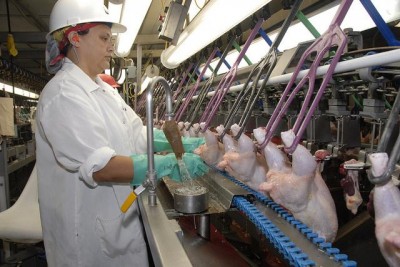|
Listen To The Article
|

Image source: cidrap.umn.edu
The United States Department of Agriculture (USDA) wants to end most federal inspection of poultry in slaughterhouses and speed up the processing lines – an idea that will only harm America’s food safety.
That’s the conclusion of a number of food safety groups and Mother Jones magazine writer Tom Philpott after examining new USDA plans for poultry inspection.
The idea behind the plan is to greatly speed up production at corporate-owned slaughterhouses for chickens and turkeys. The plan would accomplish this by removing three out of four USDA inspectors from slaughterhouses which could speed up production by 25 percent. The USDA even says it would improve food safety – a claim with which many groups disagree.
Under the current system the inspectors watch the chicken and turkey carcasses being butchered for contamination and other problems. Under the new system slaughterhouse employees would watch most of the carcasses. The plant inspectors would be responsible for examining even more birds than current inspectors watch.
The US Government Accountability Office (GAO) said in September the USDA has not fully evaluated the pilot programs and that more studying needs to be done before the new rules are put in place. Food safety, GAO said, is at risk.
This handbook provides an introduction to key aspects of raising and breeding chickens.
How it could harm food safety
Documents released by the USDA indicate that the new rules could be implemented as early as September 2014.
The rules will benefit large corporations at the effect of public safety, Philpott charges. Among the allegations against the reforms:
- The USDA wants to save $90 million from its budget over three years by implementing the rules.
- The poultry industry will save $256.6 million a year.
- The reforms primarily benefit several big corporations including Tyson Foods, Purdue, JBS (owner of Pilgrim’s Pride), Sanderson and Butterball.
- Under the new rules the slaughterhouses would be able to process up to 10,000 carcasses an hour.
- Some slaughterhouses would be able to process 175 birds a minute or three per second – and inspectors would be responsible for watching them.
- A USDA inspector reported spotting “visible fecal contamination that was missed by company employees.”
- Chicken necks stored at one slaughter house were contaminated fecal material and the contents of the chickens’ digestive systems.
- Some of the carcasses at slaughterhouses where new rules were being tested still had feathers on them.
- The USDA plans to eliminate 800 food inspectors from the nation’s poultry slaughterhouses. That would be three out of four poultry inspectors
Corporate profits trump food safety
Critics say the USDA is putting corporate profits ahead of food safety and the health of American families. Instead of tighter inspection to reduce foodborne illness, the agency is trying to demolish regulations and reduce the amount of food inspection – all in the name of food safety.
The Los Angeles Times opposed the new rules in an editorial, “Is USDA playing chicken with chickens?” The Times wrote:
New processes, however, have a way of looking better during pilot programs, when everyone is being watched carefully and has an incentive to do things right, than they do in the ordinary day-to-day grind of business. Considering the number of food safety problems that have occurred in recent years, this privatizing of much of the inspection process strikes us as a recipe for trouble.
Unlike bona fide government inspectors, plant employees will be all too aware that whenever they pull a product off the line, they’re costing money to the company that employs them. So even if the owners and managers are scrupulous about not pressuring employees, there’s a built-in incentive to let marginal problems pass through.
This incident, critics say, shows why it is so important for families to stop relying on the government and big business to ensure food safety. As Off The Grid News previously reported, a major study showed that free-range chickens are less like to have salmonella than are chickens from poultry plants.
 Off The Grid News Better Ideas For Off The Grid Living
Off The Grid News Better Ideas For Off The Grid Living




